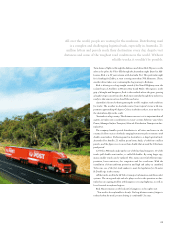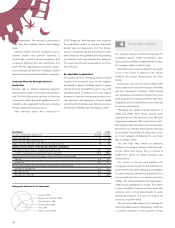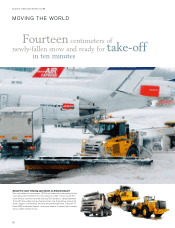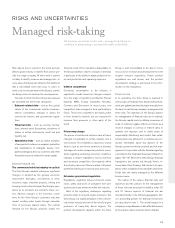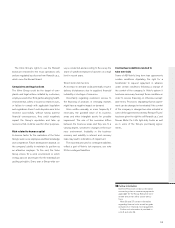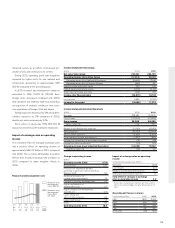Volvo 2010 Annual Report Download - page 56
Download and view the complete annual report
Please find page 56 of the 2010 Volvo annual report below. You can navigate through the pages in the report by either clicking on the pages listed below, or by using the keyword search tool below to find specific information within the annual report.
BOARD OF DIRECTORS’ REPORT 2010
Volvo’s goals are strong and stable credit
ratings
A long-term competitive market position requires
availability of capital to implement investments.
The financial strategy ensures that the Group’s
capital is used in the best possible manner by:
• balancing shareholders’ expectations on returns
with creditors’ demands for reliable security
• strong and stable credit ratings
• diversified access to financing from the capital
markets
• margin in the balance sheet to cope with a
strong decline in the economy
• customer financing at competitive conditions to
our customers
• favorable return to shareholders.
The goal concerning capital structure is defined
as the financial net debt for the Industrial Opera-
tions and it shall under normal circumstances be
below 40% of shareholders’ equity.
Volvo carefully monitors the trend of financial
key ratios to confirm that the financial position is in
line with the Group’s policy. The financial key ratios
include order intake, operational development and
financial development.
Measures to improve the financial position
The strong upswing in demand for the Group’s
products in 2010 improved the Volvo Group’s
financial position. The financial net debt in Indus-
trial Operations declined during the year from
70.9% of shareholders’ equity to 37.4%. The
Group implemented comprehensive measures
during the year to improve its financial position.
During the global financial crisis, the Volvo
Group increased the ratio of liquidity relative to
sales. As a consequence of the financial markets
stabilizing, the ratio was lowered during 2010. To
further support the goal of improving the financial
position, the 2010 Annual General Meeting
resolved not to pay any dividend for the 2009
fiscal year.
Volvo strives for strong, stable credit
ratings
The Volvo Group has continual meetings with the
credit rating agencies Moody’s and Standard &
Poor’s (S&P) to update them on the company’s
development. These meetings contribute to the
credit rating agencies’ ability to assess the
Group’s future ability to repay loans. A high long-
term credit rating provides access to additional
sources of financing and improved access to the
financial market.
On November 15, S&P changed Volvo’s credit
rating from BBB-/Baa3 with negative outlook to
BBB-/Baa3 with stable outlook. The change was
attributable to a change in Volvo’s credit measure-
ment. S&P also changed Volvo’s financial risk pro-
file to “Medium” from earlier “Significant”.
Moody’s corporate rating of Volvo is BBB/Baa2
with stable outlook since July 24, 2009.
Funding
Volvo works actively for good balance between
short and long-term loans, as well as loan prepar-
edness in the form of credit facilities, to satisfy
the Volvo Group’s long-term financing needs.
During the year, the Group diversified its loans
by issuing an Asset Backed Security loan in the
US for the first time.
At the end of 2010, the Group had the equiva-
lent of SEK 32.7 billion in cash and cash equiva-
lents and short-term investments. In addition, the
Group had SEK 35.3 billion in granted but unuti-
lized credit facilities.
FINANCIAL STRATEGY
Balancing return and security
The purpose of Volvo’s long-term financial strategy is to ensure
the best use of Group resources in providing shareholders with a
favorable return and offering creditors reliable security.
Credit rating at February 15, 2011
Short-term Long-term
Moody’s P-2 Baa2 stable
Standard & Poor's A-3 BBB- stable
DBRS R-2 (high) –
R&I (Japan) a-1 A- positive
52



